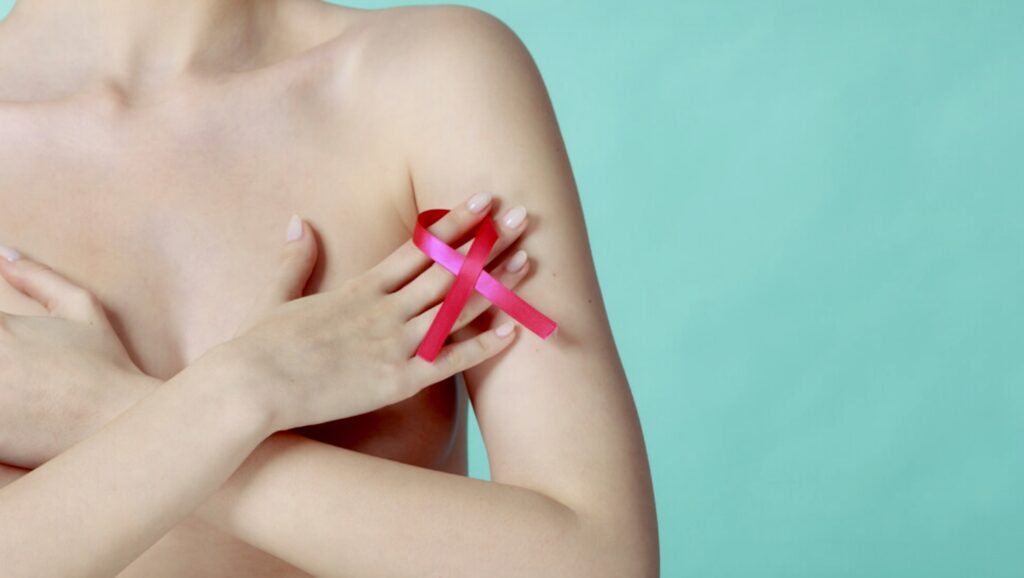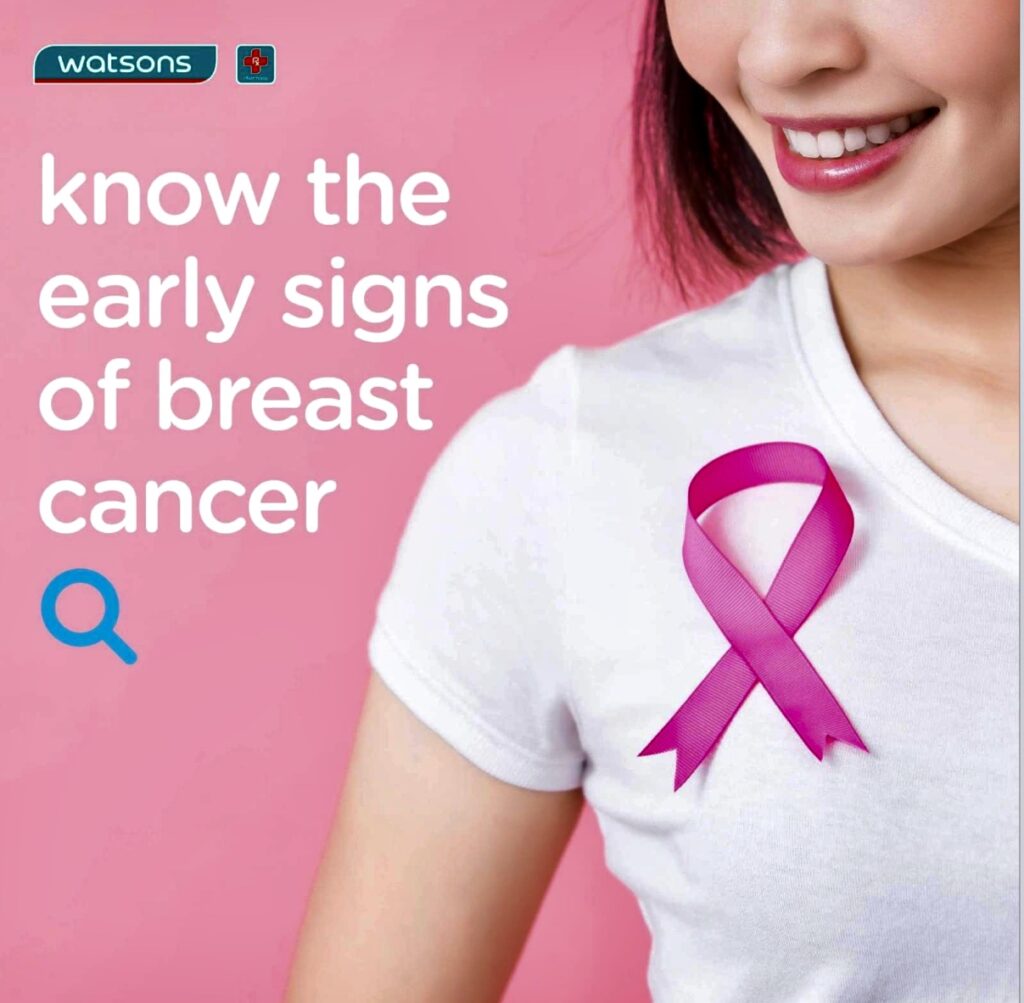BREAST CANCER: WOMEN’S NUMBER ONE KILLER
By Henrylito D. Tacio
Photos: watsonshealth.com.ph
“Breast cancer is one of the most common types of cancer among women,” said Watsons Philippines in its Facebook account. “Early detection can significantly increase the chances of successful treatment and survival.”
Around the world, breast cancer is the leading killer of women ages 35 to 54. More than a million develop the disease without knowing it, and almost 500,000 women die from it every year, according to the International Agency for Research on Cancer.
In Asia, the Philippines has the highest incidence rate of breast cancer. Not only that, it is among the top 10 countries with the most cases of breast cancer, according to a document released by the Asian Hospital and Medical Center (AHMC).

Both the Department of Health (DOH) and the Philippine Cancer Society, Inc. (PCSI) consider breast cancer as the most common form of cancer in the country – particularly among women. “One out of every 13 Filipino women is expected to develop breast cancer in her lifetime,” the AHMC document stated.
The Geneva-based World Health Organization (WHO) reports that one out of four women who are diagnosed with breast cancer die within the first five years. What is even alarming is that all women are at risk, with approximately 70% of breast cancers occurring in women without the known risk factors.
“And the numbers continue to rise at an alarming rate for the simple reason that most women only consult a doctor when it is too late,” the AHMC says.
Dr. George Crile, Jr., author of “What Women Should Know About the Breast Cancer Controversy,” defines breast cancer as “a malignant tumor that starts either in milk glands or in the ducts that carry the milk to the nipple. The cancer tends to metastasize (spread) to the lymph nodes in the armpit and to the nodes behind the breast bone. It can also spread widely throughout the body, especially to bones, lungs and liver.”
According to Dr. Crile, breast cancer is not caused by the following: sexual relations; germs introduced through the nipple; blows, bites or bruises; having babies or nursing babies; contact with someone having the disease; and the use of female hormone (estrogen) or the contraceptive pill.

“Although we are quite sure that the above factors do not cause cancer of the breast, much less is known with certainty about what does cause it,” Dr. Crile stresses in his book.
Breast cancer can strike at any age, but it usually affects women over 35. “Age is the strongest risk factor for this disease,” wrote Sue Ellin Browder in a special report for “Reader’s Digest.”
Family history is another high risk factor. This is when a member of the family (mother, aunt, sister, or cousins) has had breast cancer. A woman who has had certain kinds of non-malignant tumors removed from her breast is also at risk.
Other possible candidates for the disease are women who menstruate early (before age 12) or had a late menopause (after age 50). A woman who is childless or has her first child at age 30 is most likely to develop breast cancer.
A study done in the United States claims that women who smoke face an increased risk of dying of breast cancer. The more cigarettes a woman smokes and the longer she has smoked, the greater the risk. Those who smoked two packs or more a day, for instance, were 75% more likely to develop breast cancer than were non-smokers.
If a woman avoids smoking but drinks alcoholic beverages, she’s not spared. Studies show that the risk of breast cancer rises 11% if a woman regularly drinks once a day, 24% with two drinks and 40% with more than two, according to research by Lenore Kohlmeier, a professor of epidemiology and nutrition at the University of Carolina.
Researchers have likewise agreed that a diet rich in fat is likely to cause breast cancer. “Researchers have known for more than 40 years that high-fat diet promote the growth of mammary tumors in laboratory animals. They have also observed that the varying rates of breast cancer in various countries correlate neatly with the amount of fat in a nation’s diet,” wrote Claudia Wallis in a “Time” feature.
Ann Misch, of the Washington-based Worldwatch Institute, reported that breast cancer rates are lower in developing countries, where women eat lea diets composed mostly of carbohydrates in the form of grains and vegetables. Meat, when it is available, is used as a condiment or for flavoring, and is hardly the centerpiece as it is in Western meals.
But as developing countries experience an economic boom, their eating habits also change. Because of this, breast cancer has become one of the fastest-growing diseases among women. “Breast cancer is spreading in some developing countries, where deaths due to breast cancer were once negligible,” the United Nations health agency admitted.
In the Philippines, for instance, breast cancer is now the number killer among women. “What was once thought of as a disease of developed countries is now a major public health problem here,” a health official said.
WHO experts say the vast majority of women with breast cancer in poor countries are diagnosed only after the cancer has reached a late, untreatable stage. “Many Third World women are unaware that they are at risk of breast cancer and do not know how to examine themselves for signs of the disease,” the WHO says.
It is women themselves who can do something to detect the disease and prevent it from reaching an incurable stage. “Women can do breast self-examination (BSE) a week after menstruation,” the Philippine Cancer Control Program of the health department states.
The BSE can be done while under the shower, before going to bed at night or upon waking up in the morning. A powder or soap over the breast may be used to make the examination easier. If married, a husband can help her in the breast examination. Any mass felt should lead to a physician.
Here are the directions from the Philippine Cancer Society, Inc. (PCSI) on how to practice BSE:
In the shower or while taking a bath: Examine your breasts. Your hands will glide easily over wet skin. Fingers flat, move gently over every part of each breast. Use your right hand to examine the left breast, the left hand to examine the right. Check for any lump, hard knot, or thickening.
Before a mirror: Inspect your breast with arms at your sides. Next, raise your arms high overhead. Look for any changes in contour of each breast– a swelling, dimpling of the skin, or changes in the nipple. Then, rest palms on hips and press down firmly to flex your chest muscles. Left and right breasts will not exactly match — few women’s breasts do. Regular inspection shows what is normal for you and will give you confidence in your examination.
Lying down: To examine your right breast, put a pillow or folded towel under your right shoulder. Place the right hand behind your head — this distributes breast tissue more evenly on the chest. With the left hand, fingers flat, at the outermost top of your right breast, make small circular motions all the way around the outer edge of the breast until you reach the top again, pressing gently all the while. (Don’t panic if you find a ridge or firm tissue in the lower curve of each breast; it’s normal.)
Then move in an inch toward the nipple and repeat the procedure. You will probably have to circle your breast three additional times so that every part — including the nipple — is examined. Now, slowly repeat the whole procedure on your left breast with a pillow under your left shoulder and your left hand behind your head. The whole time, take note of how your breast structure feels. Finally, squeeze the nipple of each breast gently between the thumb and index finger.
In early stages, breast cancer usually has no symptoms. As a tumor progresses, a woman may experience pain or tenderness in her breast. She may also observe swelling in the armpit. But the most apparent symptom is a lump in the breast.
Aside from lump, other indicators include a noticeable or indentation on the breast; a change in the contour, texture, or temperature of the breast; a change in the nipple, such as an indrawn or dimpled look, itching or burning sensation; and unusual discharge from the nipple that may be clear, bloody, or another color.
The earlier a cancerous lump is detected and removed, the bigger the chances of treating it, says Dr. Antonio Villalon, an oncologist at the Manila Doctors Hospital. He advised that between 20 and 39 years old, every woman should have a clinical breast exam every three years; and after age 40 every woman should have a clinical breast exam done each year.
Mammograms — a type of X-ray — are the chief way now to check for breast cancer. However, a radioactive tracer that “lights up” cancer hiding inside dense breasts showed promise in its first big test against mammograms, revealing more tumors and giving fewer false alarms. The experimental method — molecular breast imaging (MBI) — would not replace mammograms for women at average risk of the disease.
But it might become an additional tool for higher risk women with a lot of dense tissue that makes tumors hard to spot on mammograms, and it could be done at less cost than magnetic resonance imaging, according to the Mayo Clinic in Rochester, Minnesota, which has been working on it for six years.
If diagnosed with breast cancer, Dr. Villalon said this can be treated by surgery, hormonal treatment, chemotherapy and radiotherapy. In the United States, some researchers are exploring treatment with various forms of immunotherapy; by manipulating the body’s immune system, they hope to improve its natural resistance to cancer.
Some studies have shown that women can avoid breast cancer by doing the following:
· Do regular exercise (three times a week for one hour each) has been found to lower breast cancer by up to 40 percent. Breastfeeding and having children at a younger age also lower breast cancer risk.
· Take plant estrogen such as those from soy products protect against breast cancer especially when taken regularly early in life.
· Consume folic acid (Vitamin B9), which helps repair damage in our DNA, also counter cancer. Citrus fruits, dark green leafy vegetables beans and peas are all rich in folate.
· Avoid smoking and secondhand smoke. Tobacco and its many components such as nicotine and tar are proven carcinogens. Drinking alcoholic beverages moderately helps. Also, avoid unprotected sex, drug use and other high risk behaviors.
· Know your family’s medical history. Having a history of breast cancer in one’s family greatly increases one’s risk and should make one extra vigilant.
· Conduct regular medical and breast self-examination.

